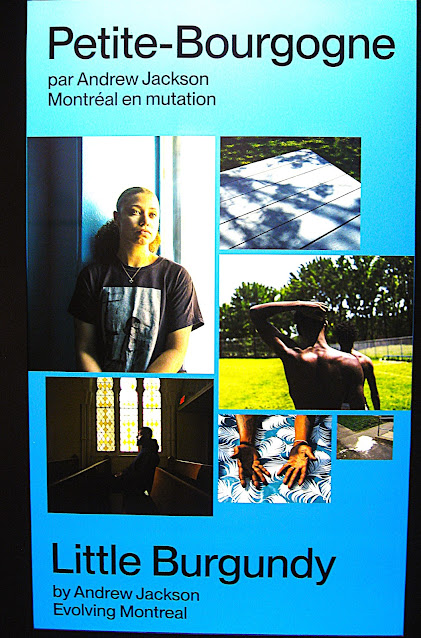Andrew Jackson: Little Burgundy
Evolving Montreal series
Black space: Resistance, resilience and the search for belonging
February 21 - September 28, 2025
The Montreal’s McCord Stewart Museum presents a new exhibition, a foray into a south-western district of the city called Little Burgundy. Over a two-year period, the photographer Andrew Jackson documented important landmarks for the Black community and met people who grew up there and still have ties to the area, and also those who live there now. The result is an exhibition featuring 61 photographs of the individuals and sites that bear witness to the urban and social transformations that have impacted Little Burgundy. In addition, three hard-hitting yet touching short films capture local residents’ lived experiences. The exhibition also features some twenty objects and images selected by Andrew Jackson from the Museum’s collection. These artefacts, juxtaposed with contemporary objects loaned by residents, create a dialogue between the past and the present.

Through this project, the photographer exposes the duality involved in designating a place or neighbourhood as a “Black space.” For Black people, it invokes a sense of security, freedom and belonging, while for non-Black persons it conveys a negative image. Andrew Jackson elaborated:
“When city spaces, such as Little Burgundy, are designated as Black spaces, there are profound implications for Black occupants. This is especially true in North America, where historically, in non-Black minds at least, Black spaces have not existed as places of acceptance or celebration of difference. Rather, they have been linked to notions of failure – notions that become catalysts for urban renewal, gentrification and the ensuing erasure of Black communities.”
Black space: a pilgrimage site
As part of his research carried out for the Evolving Montreal photographic commission, Andrew Jackson investigated how Black spaces – both physical and discursive – are experienced by Black communities. He is especially interested in how these sites are created and maintained, whether tangibly or symbolically, as historically occupied physical spaces. His work highlights how these spaces continue to exist in collective memory and how attachment to them endures long after they have been obliterated by urban renewal and the new communities moving in. As Andrew Jackson stated: “This is so powerful that long after Black residents have left, involuntarily or otherwise, they continue to make the pilgrimage of return.”

Little Burgundy
Although the Black population today makes up only about 18% of the neighbourhood’s 11,000 inhabitants, Little Burgundy remains an important historical site for the community. As one of Quebec’s first Black neighbourhoods, it offers a unique perspective on the impact of urban renewal and gentrification on historic populations, as experienced in Montreal and throughout North America in the 20th century. While certain important gathering places like the Union United Church – the oldest Black congregation in Canada – now find themselves outside the neighbourhood’s contemporary borders, they remain intimately linked to the history of the community that founded and animated them.
Andrew Jackson
Andrew Jackson is a British-Canadian photographer based in Montreal since 2019. His practice is developed at the intersection of photography and text and, most recently, focuses on notions of family, transnational migration, displacement, trauma, war and collective memory. He recently published the monograph From a Small Island, the first chapter of his ongoing series Across the Sea Is a Shore, a collection of works that explore the inter-generational legacies of migration from the Caribbean to the UK. Jackson has a history of developing platforms that provide opportunities for traditionally excluded groups to engage with photography. In 2021 he created a public engagement project in collaboration with the DESTA Black Youth Network, located in Little Burgundy, which resulted in a group exhibition shown at the PHI Foundation. His works are held in public collections that include the United Kingdom’s Government Art Collection, the Permanent Collection of the New Art Gallery Walsall and the Autograph ABP and Light Work collections. His photographs have also appeared in such publications as the Los Angeles Times, The Guardian, the Financial Times and The New Statesman.
Curatorial and production team
An exhibition produced by the McCord Stewart Museum.
Artist: Andrew Jackson
Curator: Zoë Tousignant, Curator, Photography, McCord Stewart Museum
Project management: Eve Martineau, Coordinator, Exhibitions, McCord Stewart Museum
Design: David Martin
Audiovisual production: Tomi Grgicevic
Programming related to the exhibition
Round table: Occupying Space, Shaping Community
Wednesday, March 19, 2025, 6 to 7p.m. – At the Museum – Free In collaboration with Art Souterrain
Little Burgundy: Conversation with artist Andrew Jackson and Zoë Tousignant Wednesday, May 28, 2025, 6 to 7p.m. – At the Museum – Free
Discussion workshop on Black spaces in Montreal: Speaking Up, Speaking Out Wednesday, September 10, 2025, 6 to 7:30p.m. – At the Museum – Free
Evolving Montreal series
McCord Stewart Museum’s President and CEO Anne Eschapasse stated:
“After Robert Walker, who photographed Griffintown, and Joannie Lafrenière, who captured Hochelaga-Maisonneuve, we’ve commissioned Andrew Jackson to explore the urban transformations that have occurred in Little Burgundy, as well as its residents’ experiences and memories of such transformations, as part of our Evolving Montreal series. The resulting exhibition is an opportunity to discover Montreal’s Black communities and a neighbourhood whose identity was irrevocably altered in the name of ‘urban renewal’ in the late 1960s and 1970s.”
1. Robert Walker, who photographed Griffintown, here.
2. Joannie Lafrenière, who captured Hochelaga-Maisonneuve, here.
All photos @ Nadia Slejskova
The dedicated internets address of this article or click on the title above the first photo at the top.
For more information about current exhibitions and special evens associated with this exhibition, visit the McCord Stewart Museum website.












No comments:
Post a Comment